
The Laser is a class of single-handed, one-design sailing dinghies using a common hull design with three interchangeable rigs of different sail areas, appropriate to a given combination of wind strength and crew weight. Ian Bruce and Bruce Kirby designed the Laser in 1970 with an emphasis on simplicity and performance.

The 470 (Four-Seventy) is a double-handed monohull planing dinghy with a centreboard, Bermuda rig, and centre sheeting. Equipped with a spinnaker, trapeze and a large sail-area-to-weight ratio, it is designed to plane easily, and good teamwork is necessary to sail it well. The name comes from the boat's length of 470 centimetres.

The Yngling is a sailboat that was designed by Norwegian Jan Herman Linge as a one design racer and first built in 1967.
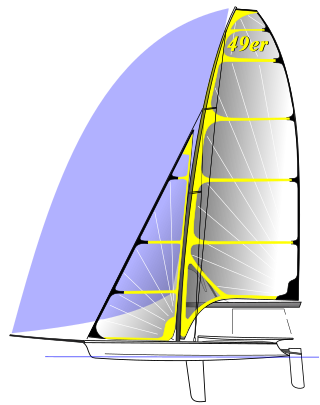
The 49er and 49er FX is a two-handed skiff-type high-performance sailing dinghy. The two crew work on different roles with the helm making many tactical decisions, as well as steering, and the crew doing most of the sail control. Both of the crew are equipped with their own trapeze and sailing is done while cantilevered over the water to the fullest extent to balance against the sails.
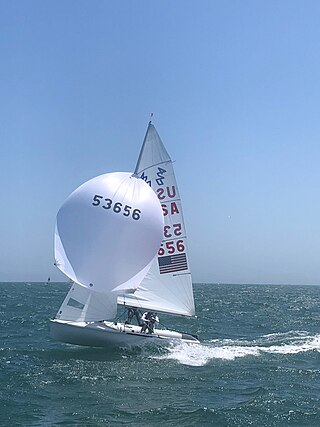
The International 420 Dinghy is a sailing dinghy popular for racing and teaching. The hull is fiberglass with internal buoyancy tanks. The 420 has a bermuda rig, spinnaker and trapeze. It has a large sail-area-to-weight ratio, and is designed to plane easily. The 420 is an International class recognised by World Sailing. The name refers to the boat's length of 420 centimetres.

The J/24 is an international One-Design and Midget Ocean Racing Club trailerable keelboat class built by J/Boats and defined by World Sailing. The J/24 was created to fulfill the diverse needs of recreational sailors such as cruising, one design racing, day sailing, and handicap racing.
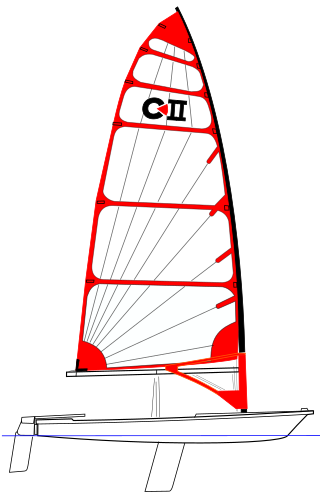
The Byte is a small one-design sailing dinghy sailed by one person. It was designed by Canadian Ian Bruce, who also commissioned and marketed the Laser.
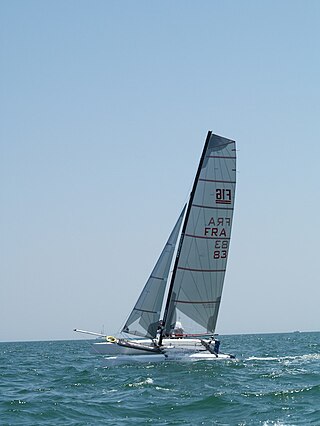
The Formula 16 (F16) sport catamaran is an ISAF recognised 5 m long beach catamaran with an asymmetric spinnaker setup.

Paul Pierre Cayard is an American yachtsman and professional sailor. He has competed at multiple world championship level sailing events, including the America's Cup, the Whitbread Round the World Race, the Volvo Ocean Race and the Olympic Games. In 1998 he was selected as the US Rolex Yachtsmen of the Year. He has won seven world championships, twice participated in the Olympic Games and seven times in the America's Cup. In 2011 he was elected into the US Sailing Hall of Fame.

The Farr 40 is a 40-foot one-design sailboat designed by Farr Yacht Design in 1996 following after the Mumm 30. It was originally designed as a one design class but had some compromises in design to rate under the International Measurement System (IMS) rule. The class has held World Sailing class status since 1997.

ORMA 60 is a class of sailing trimarans administered by the Ocean Racing Multihull Association (ORMA) that created in 1996 by the International Sailing Federation (ISAF) within the sport of sailing. The boats were built to a box rule that permitted 60 feet length and beam and a 100-foot mast.
The SL 16 is a 4.80 m long fiberglass sailing catamaran. It is designed to be sailed by two people. The SL 16 was selected by ISAF in 2005 for the Youth Sailing World Championships.

The RS Tera is a one-man monohull dinghy in the RS Sailing range of sailing boats. It is recognised by the International Sailing Federation (ISAF) as an international class, and is a popular boat for beginners and for children to race.

RS:X is a windsurfing class selected by the ISAF to replace the Mistral One Design Class for the 2008 Summer Olympics. The discipline has similarities to Formula Windsurfing - mainly in that the equipment used was designed to allow windsurfing in low and moderate wind conditions with good performance.
The International Radio Sailing Association (IRSA) formerly the ISAF Radio Sailing Division is an affiliate member of World Sailing that sanctions radio-controlled sailing competitions. It is authorised by WS to conduct up to three official World Championships each year.
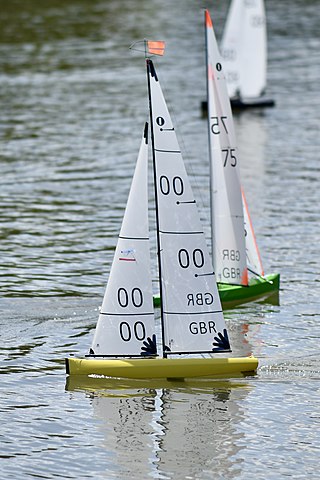
The International One Metre (IOM) is a class of Radio Sailing Boat used for racing under the World Sailing - Racing Rules of Sailing. It is a measurement-controlled box rule originally created by the ISAF-RSD (now the International Radio Sailing Association) in 1988 in an attempt to harmonise the various one metre rules created around the world. The IOM Class Rules specify a standardised sail plan and control of the other major performance dimensions (displacement, length, and draught) while allowing some freedom in hull design. The IOM is now the largest and arguably most competitive of all radio sailing classes.

The International Radio A Class (RA) is a class of radio controlled sailing yacht used for competitive racing. It is a measurement controlled classes administered by the International Radio Sailing Association. The class is a designated IRSA International class entitled to hold World Championships officially recognised by the International Sailing Federation. A RA class of boat is a classic looking boat similar to that of the full sized metre class. The RA class rules are loosely based on the 5.5 Metre. Modern boats use the latest carbon fibre technology with displacements typically between 13 – 16 kg, making them substantial yachts.

The Platu 25 is a sailing boat designed by Farr Yacht Design led by Bruce Farr with the first boat being built by McDell Marine in New Zealand in the early 1990s. It became a class recognised by the International Sailing Federation in November 2006.
World championships in sailing are world championships organised or sanctioned by World Sailing. As a sport, sailing has the largest number of world championships due to the diversity of equipment and disciplines.

The Nacra 17 is a performance catamaran used for sailing. It was designed in 2011, went into production in 2012 and has been the focus of multihull sailing at the Olympic Games since its conception.

















